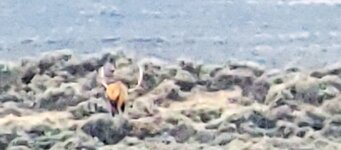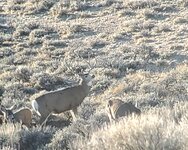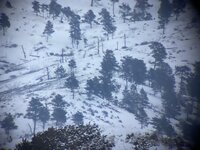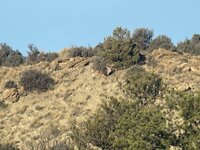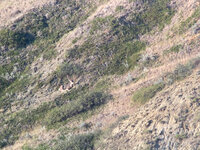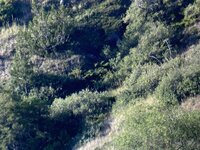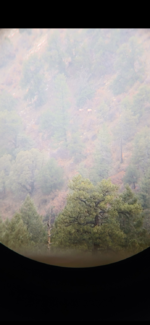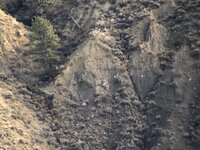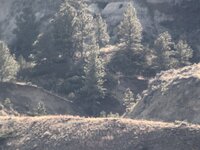Hello everyone, I will be embarking on my first western hunt in a mountainous region of Idaho next October. Clearly glassing is an important aspect of the hunt but unfortunately I do not have anywhere to practice that skill where I live in MA. I wanted to see if anybody would be willing to share pictures of Mule deer (or elk) spotted while glassing. I want to start learning what a mule deer looks like in similar terrain and maybe get an idea of where to focus my attention while glassing as well. I appreciate your help!
You are using an out of date browser. It may not display this or other websites correctly.
You should upgrade or use an alternative browser.
You should upgrade or use an alternative browser.
Glassing Photos
- Thread starter Jimmyf123
- Start date
Primal-Understanding
Lil-Rokslider
Don't have any pictures, but here are some pointers, in no particular order, that should make you more effective:
- Glass through a hierarchy. Start by glassing with your naked eye, when you have the largest perspective its easiest to pick out movement and any major contrasts. This is also important to identify any dead space (topographical or concealment) and to identify the areas you can see and could effectively hunt. Then move to binos and finally your spotter. Depending on the area I am glassing, I will be on my binos for 80% of the time and spotter for 20%.
- Glass right to left, studies have shown that this will cause your mind to process the visual information more effectively as humans are used to processing things from left to right and have a tendency to overlook things due to the familiarity of information and the drive to do things quickly. Brady Miller got me onto this and I think there is truth behind it.
- When you don't turn up any animals within the area you are glassing, start looking for mule deer butts or antlers - something specific. This helps your mind continue to break down the same visual information in different ways. If your eyes/ brain are looking to identify whole animals they may not register the white rump sticking out from behind sagebrush.
- Take breaks! You're going to be spending hours a day glassing and the longer you sit without seeing anything the less effective you are probably becoming behind the glass. Sometimes for me this just means heating up a drink in the jetboil and sitting back taking in the moment and letting your mind be at ease. Other times its nice to get up and move around - if you do this remember there may be animals that can see you.
- Glass through a hierarchy. Start by glassing with your naked eye, when you have the largest perspective its easiest to pick out movement and any major contrasts. This is also important to identify any dead space (topographical or concealment) and to identify the areas you can see and could effectively hunt. Then move to binos and finally your spotter. Depending on the area I am glassing, I will be on my binos for 80% of the time and spotter for 20%.
- Glass right to left, studies have shown that this will cause your mind to process the visual information more effectively as humans are used to processing things from left to right and have a tendency to overlook things due to the familiarity of information and the drive to do things quickly. Brady Miller got me onto this and I think there is truth behind it.
- When you don't turn up any animals within the area you are glassing, start looking for mule deer butts or antlers - something specific. This helps your mind continue to break down the same visual information in different ways. If your eyes/ brain are looking to identify whole animals they may not register the white rump sticking out from behind sagebrush.
- Take breaks! You're going to be spending hours a day glassing and the longer you sit without seeing anything the less effective you are probably becoming behind the glass. Sometimes for me this just means heating up a drink in the jetboil and sitting back taking in the moment and letting your mind be at ease. Other times its nice to get up and move around - if you do this remember there may be animals that can see you.
Last edited:
- Banned
- #3
William Sublette
WKR
RS_Non-Res
WKR
- Joined
- May 1, 2021
- Messages
- 379
- Thread Starter
- #5
Thanks for the advice! I like the like the idea of scanning right to left. I think having some sort of process to my glassing will definitely help.Don't have any pictures, but here are some pointers, in no particular order, that should make you more effective:
- Glass through a hierarchy. Start by glassing with your naked eye, when you have the largest perspective its easiest to pick out movement and any major contrasts. This is also important to identify any dead space (topographical or concealment) and to identify the areas you can see and could effectively hunt. Then move to binos and finally your spotter. Depending on the area I am glassing, I will be on my binos for 80% of the time and spotter for 20%.
- Glass right to left, studies have shown that this will cause your mind to process the visual information more effectively as humans are used to processing things from left to right and have a tendency to overlook things due to the familiarity of information and the drive to do things quickly. Brady Miller got me onto this and I think there is truth behind it.
- When you don't turn up any animals within the area you are glassing, start looking for mule deer butts or antlers - something specific. This helps your mind continue to break down the same visual information in different ways. If you're eyes/ brain are looking to identify whole animals they may not register the white rump sticking out from behind sagebrush.
- Take breaks! You're going to be spending hours a day glassing and the longer you sit without seeing anything the less effective you are probably becoming behind the glass. Sometimes for me this just means heating up a drink in the jetboil and sitting back taking in the moment and letting your mind be at ease. Other times its nice to get up and move around - if you do this remember there may be animals that can see you.
Depending on where you are looking for them it can become extremely difficult to find them however in other instances they stick out like sore thumbs. Here’s an example of an extremely difficult one to find. I spotted this doe purely because it flicked its ear. I’m inviting everyone to try and find the deer in this picture. I’m sure some people will find it easily however it is bedded down and not easy to find.

cmahoney
WKR
I like going slow through my binos, keeping them in one spot and moving my eyes. I found this bull in a burn a long ways away last year.


Sent from my iPhone using Tapatalk


Sent from my iPhone using Tapatalk
TL406
Lil-Rokslider
- Thread Starter
- #9
Yeah you weren’t kidding. I can’t find the doe…doesn’t bode well for my next hunt haha.Depending on where you are looking for them it can become extremely difficult to find them however in other instances they stick out like sore thumbs. Here’s an example of an extremely difficult one to find. I spotted this doe purely because it flicked its ear. I’m inviting everyone to try and find the deer in this picture. I’m sure some people will find it easily however it is bedded down and not easy to find.View attachment 500864
I’ll send you a pm so I don’t ruin it for everyone else to try and find.Yeah you weren’t kidding. I can’t find the doe…doesn’t bode well for my next hunt haha.
cmahoney
WKR
What months are you going to be glassing? Summer bucks are way easier to see compared to fall bucks



Sent from my iPhone using Tapatalk



Sent from my iPhone using Tapatalk
cmahoney
WKR
Don’t skip any mahogany either.

Sent from my iPhone using Tapatalk

Sent from my iPhone using Tapatalk
- Thread Starter
- #13
I’ll be going in late October so unfortunately the deer won’t have their summer coats. Thanks for the pics!What months are you going to be glassing? Summer bucks are way easier to see compared to fall bucks



Sent from my iPhone using Tapatalk
October bucks are tough to glass up. If it's open country, it's better, but timber country makes them tough.
They will be in the timber high to mid-mountain then and hard horned, but won't have any interest in being around other deer. May be in a bachelor group, but singles seem to be more common IME. If you see does, you are too low.
Best bets will be places that have edges. Edges of aspen stands, mahogany, scrub oak, etc where they transition to pines. Avalanche chutes. Clearcuts. Burns. Meadows are a crap shoot since deer aren't huge grass lovers. Talk to the bio in the area and ask what preferred forage is for that time of year and where on the mountain it tends to grow. Learn what those plants look like. An example would be bitterbrush that is in Idaho and deer are a fan of.
The reason for the above is to concentrate your efforts where deer are most likely. Especially if they are timbered up and otherwise hidden. If you get snow (and hope you get some) tracking becomes an option.
Might be worth $10 to get the Graylight app that Robbie reviewed a little while ago. One of the better mule deer hunting info sources that I've seen. Steps through the whole process of hunting deer.
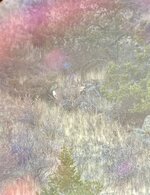

Jeremy
They will be in the timber high to mid-mountain then and hard horned, but won't have any interest in being around other deer. May be in a bachelor group, but singles seem to be more common IME. If you see does, you are too low.
Best bets will be places that have edges. Edges of aspen stands, mahogany, scrub oak, etc where they transition to pines. Avalanche chutes. Clearcuts. Burns. Meadows are a crap shoot since deer aren't huge grass lovers. Talk to the bio in the area and ask what preferred forage is for that time of year and where on the mountain it tends to grow. Learn what those plants look like. An example would be bitterbrush that is in Idaho and deer are a fan of.
The reason for the above is to concentrate your efforts where deer are most likely. Especially if they are timbered up and otherwise hidden. If you get snow (and hope you get some) tracking becomes an option.
Might be worth $10 to get the Graylight app that Robbie reviewed a little while ago. One of the better mule deer hunting info sources that I've seen. Steps through the whole process of hunting deer.


Jeremy

Her face is sticking out of the sage brush, nose is facing to the right.Depending on where you are looking for them it can become extremely difficult to find them however in other instances they stick out like sore thumbs. Here’s an example of an extremely difficult one to find. I spotted this doe purely because it flicked its ear. I’m inviting everyone to try and find the deer in this picture. I’m sure some people will find it easily however it is bedded down and not easy to find.View attachment 500864
WI in the west
WKR
These where all found with the binos at around 1/2 a mile then took a photo with the spotter. The one wuth just the antlers stood up stretched for a minute i spotted him then layed back down. Once i knew where and what to look for id find him easily woth the binos just how the picture is. Just got to see a few to get your eyes in a groove.
Attachments
kodyshriver
FNG
- Joined
- May 17, 2016
- Messages
- 82
Nickofthewoods
WKR
mistermystery
FNG
- Joined
- Aug 26, 2021
- Messages
- 43
I spotted this small buck with a 30x spotter. I likely would have never seen it once it bedded down. Also added this picture of a bull sitting on a little hidden bench. As the others have said, getting your glass rock steady makes all the difference.
Attachments
AZ_Hunter_2000
WKR
- Joined
- Oct 8, 2019
- Messages
- 2,956
This is my personal opinion and folks can feel free to disagree...Hello everyone, I will be embarking on my first western hunt in a mountainous region of Idaho next October. Clearly glassing is an important aspect of the hunt but unfortunately I do not have anywhere to practice that skill where I live in MA. I wanted to see if anybody would be willing to share pictures of Mule deer (or elk) spotted while glassing. I want to start learning what a mule deer looks like in similar terrain and maybe get an idea of where to focus my attention while glassing as well. I appreciate your help!
The approach to glassing should not change based upon the target species. I do not change my glassing approach when hunting Coues, mule deer, javelina, black bear, elk, bobcat, coyote, mountain lion, mountain goat, Dall sheep, desert bighorn sheep, grizzly bear, jackrabbits, etc. You can drop my butt off on a mountain in Kazakstan for an ibex and my approach will not change.
The individual should be looking to identify all animals in an area and then filter out what is irrelevant. It'd be stupid to ignore that grizzly 200 yards to your right (not your target species) and only focus on that elk 600 yards in front of you (your target species). I just went through this with a Coues buck and a tom that was actively looking for food.
An individual can practice the glassing process anywhere. Go to a park, local hiking trail, etc and practice glassing. I periodically go to a riparian reserve close to my house to practice. The identified animals change but the process stays the same. If someone asks I tell that I'm birding as to not ruffle their feathers (pun intended). Remember you want to be able to thoroughly parse an area and identify all animals.
Looking at photos is not a viable substitute for building a mental image catalog of animals. No photo is going to train your brain about that one blade of grass going against the wind is actually an obscured buck taking a step into the open. No photo is going to train your brain that the slight movement is an ear versus a lizard looking for food. While the photos posted so far are cool, most are animals fully in the open. Based upon my personal experience, animals more often tend to be partially to mostly obscured rather than posing for a National Geographic centerfold. Seeing that beautiful elk bugling photo is worthless at training my brain to identify that slight glint of light off his tine with the rest of him completely hidden.
Related to the mental image catalog, most folks are further along than they think. When hunting a deer in a tree stand, often the hunter sees bits and pieces of the deer before they see the entire deer (if that). Those are the the same bits and pieces that you see when glassing.
This is just my personal opinion based upon my personal experience chasing an assortment of animals in a variety of terrain.
Similar threads
- Replies
- 34
- Views
- 1K
Featured Video
Stats
Latest Articles
-
Gunnison Mule Deer and Beyond with Brandon Diamond
-
Idaho Mule Deer Management with Eric Freeman
-
TT#28 Idaho Bear Hunting with Roger Holscher and Chris Young
-
Rockstar Research with Kevin Monteith
-
Hunting Big Mule Deer: Obey the Wind & Still-Hunting
-
TT#27 DIY New Zealand Hunting with Australian Duo Miller and Pitts
-
Fewer Bucks, More Fawns?
-
Mathews Lift Review
-
Wyoming Range Winter Wrap-Up with Jeff Short
-
The Pursuit with Cliff Gray

